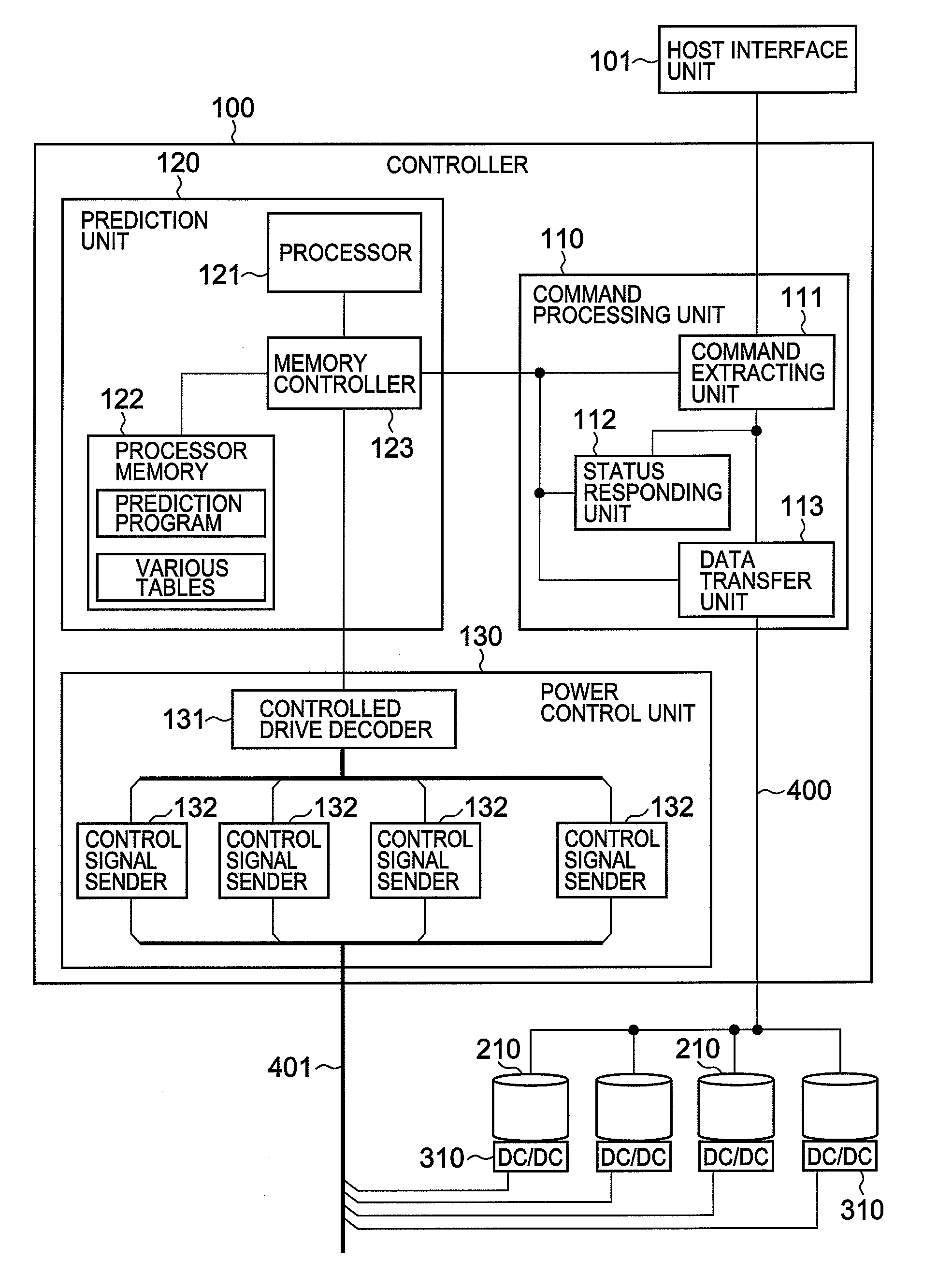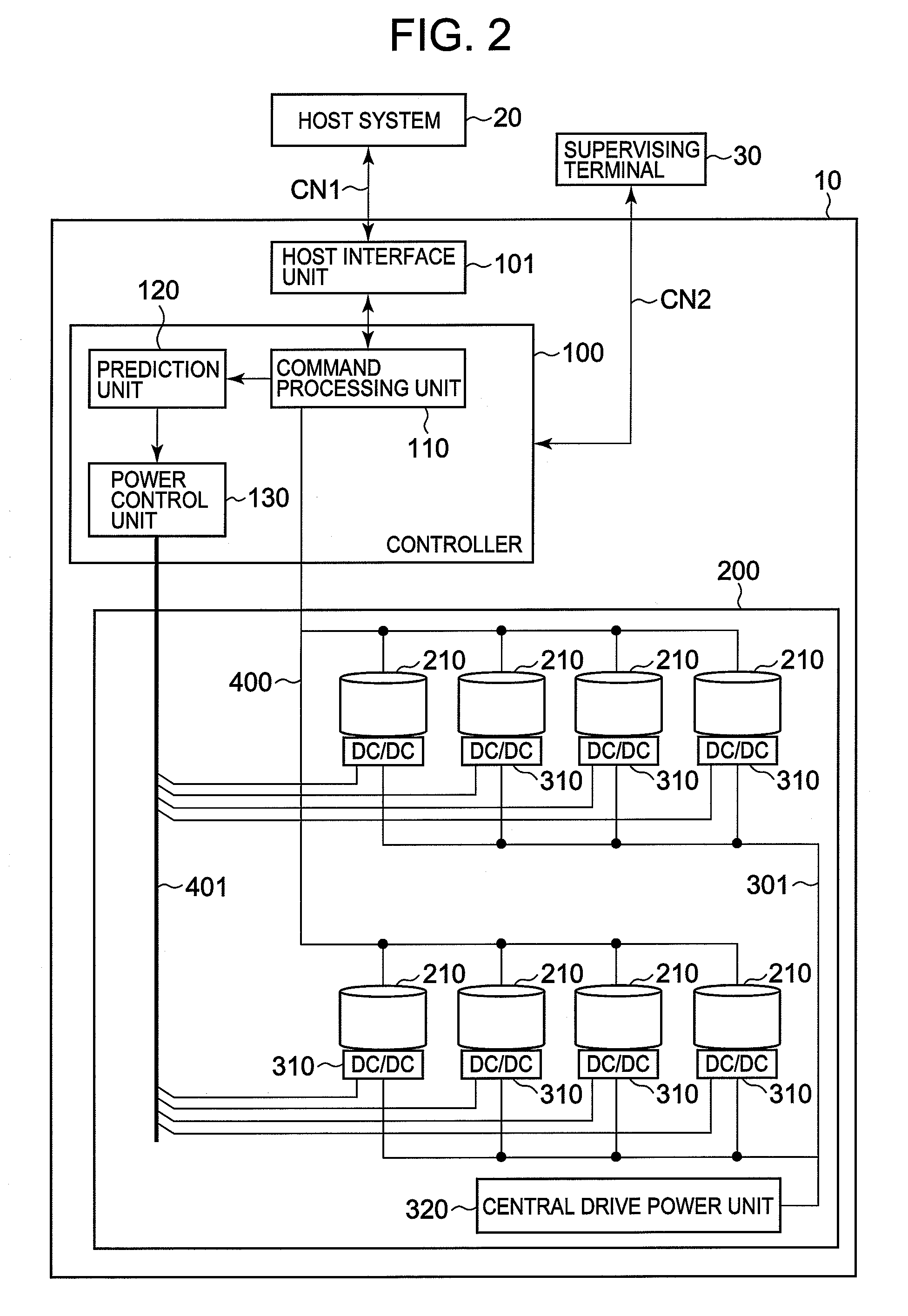Storage system and method of controlling of feeding power to storage system
a storage system and power technology, applied in the field of storage system and a control method of feeding power to a storage system, can solve the problems of reducing the amount of power a storage system consumes, the inability of the storage system to control the feeding power of a plurality of disk drives within the storage system independently, and the difficulty of reducing the access time from the host system
- Summary
- Abstract
- Description
- Claims
- Application Information
AI Technical Summary
Benefits of technology
Problems solved by technology
Method used
Image
Examples
first embodiment
[0057]FIG. 2 is a drawing showing an overall structure of a storage system. The entire system, for example, consists of a storage system 10, a host system 20, and a supervising terminal 30. The correspondent relationship with FIG. 1 will be described in advance. The storage system 10 corresponds to the storage system 1 in FIG. 1, the host system 20 corresponds to the host system 2 in FIG. 1, the disk drives 210 corresponds to the disk drives 3 in FIG. 1, the command processing unit 110 corresponds to the access processing unit 4 in FIG. 1, the power control unit 130 corresponds to the power control unit 6 in FIG. 1, the prediction unit 120 corresponds to the prediction unit 7 in FIG. 1, and the local power units 310 correspond to the power unit 5 in FIG. 1, respectively.
[0058]Host system 20, as mentioned above, is a server, mainframe or other such computer systems, and, for example, is connected to host interface unit 101 via a communications network CN1, such as a SAN (Storage Area...
second embodiment
[0117]A second embodiment of the present invention will be explained on the basis of FIGS. 9 and 10. The following embodiments, to include this embodiment, correspond to variations of the first embodiment. In this embodiment, power-on timing is delayed as much as possible by over all managing not only the sequence in which access is requested, but also access time intervals, thereby realizing even greater power savings.
[0118]FIG. 9 is a drawing showing an access pattern record table T5 utilized by a storage system 10 according to this embodiment. This table T5 has the same part as table T3 shown in FIG. 5, and, for example, is configured by making a record number I51, times of hits I52, history length I53, and access sequence I54 correspond to one another.
[0119]The difference with the table T3 shown in FIG. 5 is that, in addition to the sequence I54A in which logical volumes have been accessed, the time interval I54B of adjacent accesses is included in the access sequence I54 indica...
third embodiment
[0124]A third embodiment will be explained on the basis of FIGS. 11 and 12. In this embodiment, the feeding of power to the respective disk drives 210 is individually controlled in accordance with a schedule preset by a user.
[0125]FIG. 11 is a drawing showing a storage system, which comprises a storage system 10 according to this embodiment. A schedule setting unit 31 is provided in the supervising terminal 30. The schedule setting unit 31 can be realized as software, which provides a function for a user to set a power control-related schedule (the power-on schedule shown in FIG. 12).
[0126]FIG. 12 is a flowchart showing the process for setting a power-on schedule. When a user starts up the schedule setting unit 31 of the supervising terminal 30, a power-on schedule setting window 500 is displayed on the terminal screen (S50). The user utilizes this setting window 500 to input a power-on target logical volume 230 and power-on time (S51).
[0127]The power-on schedule setting window, for...
PUM
 Login to View More
Login to View More Abstract
Description
Claims
Application Information
 Login to View More
Login to View More - R&D
- Intellectual Property
- Life Sciences
- Materials
- Tech Scout
- Unparalleled Data Quality
- Higher Quality Content
- 60% Fewer Hallucinations
Browse by: Latest US Patents, China's latest patents, Technical Efficacy Thesaurus, Application Domain, Technology Topic, Popular Technical Reports.
© 2025 PatSnap. All rights reserved.Legal|Privacy policy|Modern Slavery Act Transparency Statement|Sitemap|About US| Contact US: help@patsnap.com



